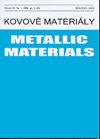Evolution of the AA2030 alloy microstructure in the ECAP process
IF 0.7
4区 材料科学
Q4 MATERIALS SCIENCE, MULTIDISCIPLINARY
引用次数: 0
Abstract
This work aims to study the microstructural development of lead-containing aluminum alloy in the process of intense plastic deformation. The evolution of the AA2030 alloy obtained by the ECAP and long-term natural aging (within 45 months) has been analyzed using electron microscopes. The average grain size of the ECAP treated samples is 420 and 380 nm along the routes Bc and C, respectively. Long-term natural aging contributes to transforming grain boundaries without changing their size. The results have shown that the structure, phase distribution, and stoichiometric composition of the inclusions differ significantly during annealing, equal-channel angular pressing, and long-term natural aging. The strain route affects the dissolution kinetics and evolution of inclusions. A mechanism for refining the grains is proposed that is associated with high dislocation density, dislocation cells, grain and subgrain boundaries, as well as the evolution of inclusions in the ECAP AA2030 alloys. K e y w o r d s: aluminum alloys, AA2030, SPD, ECAP, grains and interfaces, electron microscopyECAP过程中AA2030合金组织的演变
本工作旨在研究含铅铝合金在剧烈塑性变形过程中的组织发展。利用电子显微镜分析了经ECAP和长期自然时效(45个月以内)获得的AA2030合金的演变过程。经ECAP处理的样品沿Bc和C路线的平均晶粒尺寸分别为420和380 nm。长期自然时效有利于晶界的转变而不改变其尺寸。结果表明,在退火、等径角挤压和长期自然时效过程中,夹杂物的结构、相分布和化学计量组成存在显著差异。应变路径影响夹杂物的溶解动力学和演化。提出了一种与高位错密度、位错胞、晶界和亚晶界以及夹杂物演化有关的细化晶粒的机制。主要研究方向:铝合金,AA2030, SPD, ECAP,晶粒与界面,电镜
本文章由计算机程序翻译,如有差异,请以英文原文为准。
求助全文
约1分钟内获得全文
求助全文
来源期刊

Kovove Materialy-Metallic Materials
MATERIALS SCIENCE, MULTIDISCIPLINARY-METALLURGY & METALLURGICAL ENGINEERING
CiteScore
1.20
自引率
14.30%
发文量
36
审稿时长
3 months
期刊介绍:
Kovove Materialy - Metallic Materials is dedicated to publishing original theoretical and experimental papers concerned with structural, nanostructured, and functional metallic and selected non-metallic materials. Emphasis is placed on those aspects of the science of materials that address:
the relationship between the microstructure of materials and their properties, including mechanical, electrical, magnetic and chemical properties;
the relationship between the microstructure of materials and the thermodynamics, kinetics and mechanisms of processes;
the synthesis and processing of materials, with emphasis on microstructural mechanisms and control;
advances in the characterization of the microstructure and properties of materials with experiments and models which help in understanding the properties of materials.
 求助内容:
求助内容: 应助结果提醒方式:
应助结果提醒方式:


